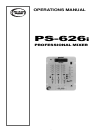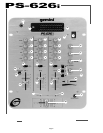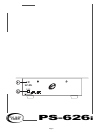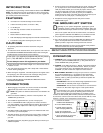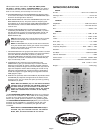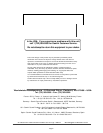
Page 5
SPECIFICATIONS
INPUTS:
DJ Mic.......................................................1.5mV 2 kΩ unbalanced
Phono @ 1 kHz..........................................................................2 mV 47 kΩ
Line...............................................................................100 mV 27 kΩ
OUTPUTS:
Amp/Booth....................................................................0 dB 775mV 400 Ω
Max...............................................................................24V Peak-to-Peak
Rec..................................................................................225mV 5 kΩ
GENERAL:
Bass .....................................................................+ 12dB/- 32 dB
Mid ..........................................................................+ 12dB/- 32 dB
Treble ..................................................................+ 12dB/- 32 dB
Gain (Mic).......................................................................0 to -40dB
Gain (Chnls 1-3).......................................................................0 to -20dB
Frequency Response............................................20Hz - 20kHz +/- 2dB
Distortion..............................................................................less than 0.02%
S/N Ratio..........................................................................better than 80dB
Talkover Attenuation........................................................................16dB
Power Source...................................................115/230V 50/60Hz 20W
Dimensions................................................254mmW x 305mmD x 112mmH
10”W x 12”D x 4 7/16”H
Weight........................................................................................6.5 lbs(3 Kg)
✦
Your Gemini mixer comes with an
RG-45 PRO (RAIL
GLIDE) DUAL-RAIL CROSSFADER
. Rail Glide™
Crossfaders have internal dual stainless steel rails that allow the
slider to ride smoothly and accurately from end to end.
4. CROSSFADER SECTION: The CROSSFADER (25) allows the mixing
of one source into another. The left side of the CROSSFADER (25) is
channel 2 and the right side is channel 3.
5. BEAT INDICATORS: Each side of the CROSSFADER (25) has its own
BEAT INDICATOR (23, 24). They flash at the low frequency peak
level allowing you to match the beats visually. BEAT INDICATOR (23)
will reflect the beat of CH2 and BEAT INDICATOR (24) will do the
same for CH3.
6. OUTPUT CONTROL SECTION: The level of the AMP OUT (38) is
controlled by the MASTER (18) control. The BALANCE (17) control
will allow the Amp Out signal to be balanced between the left and
right speakers. The BOOTH (16) control adjusts the level of the
BOOTH OUTPUT (39).
HINT: BOOTH OUTPUT (39) is used by some DJs to run monitor
speakers in the DJ Booth. You can also use it as a second
ZONE or AMP output.
NOTE: The RECORD OUT (40) has no level control. The level is
set by the channel slides and the gain controls of the selected
channel. Tonal qualities are set by the low, mid and high
controls of that same channel.
7. TALKOVER SECTION: The purpose of the talkover section is to allow
the program playing to be muted so that the mic can be heard above
the music. When the TALKOVER (19) button is pushed, the
TALKOVER INDICATOR (28) will glow and the volume of all sources
except the Mic or whatever is connected to the PHONO/LINE (36)
input are reduced by 16 dB.
8. CUE SECTION: By connecting a set of headphones to the
HEADPHONE (4) jack, you can monitor any or all of the channels.
Select the correct CUE (21) button or buttons and their respective
CUE LED (5) indicators will glow. Use the CUE LEVEL (20) control to
adjust the headphone volume without effecting the overall mix. By
sliding the CUE PGM PAN (22) control to the left you will be able to
monitor the assigned cue signal. Sliding to the right will monitor the
PGM (program) output.
9. DISPLAY: The peak hold, dual function DISPLAY (26) indicates either
the MASTER (38) output left and right levels or the channel 2 and
channel 3 levels. You can choose the option you want by pressing
the DISPLAY (27) button.
NOTE: When the DISPLAY (27) is in the channel 2/channel
3 display mode, by adjusting the individual channel gain
and tone controls, you can increase or decrease the
signal to match the other channel’s signal. The channel
slides and crossfader have no effect on the display
readings.
10. The CROSSFADER CURVE SWITCH (31) allows you to adjust the
kind of curve the crossfader has. Move switch to the “sharp” position
to make the curve steep and cutting (perfect for scratching ). Move
switch to the “gradual” position to make the curve gradual and gentle.
The CROSSFADER REVERSE SWITCH (32) allows you to reverse the
crossfader so that CHANNEL 3 is controlled by the left side of the
crossfader and CHANNEL 2 is controlled by the right side of the
crossfader.
NOTE: When the CROSSFADER REVERSE SWITCH (32) is
activated, only the crossfader reverses. The Channel
Slides, Gain, and Tonal Controls do not reverse.



